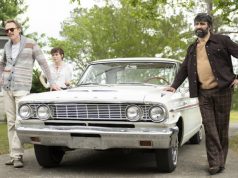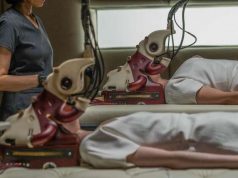Consider the emperor penguin. Go ahead, I’ll wait. Turns out the tuxedoed waiters in “Mary Poppins” weren’t far off from nature. Real penguins look alike, goof around with each other, and are oddly human in their movements and mannerisms. The word “waddle,” if not coined specifically to describe the way penguins walk, certainly describes them better than it describes anything else.
This is good news for “March of the Penguins,” a rather straightforward documentary that tells us, in simple terms, what penguins do. They spend several months in the ocean near Antarctica eating and playing, then return in the winter to their breeding grounds. There they pair up, mate, and produce an egg, whereupon the mother heads back to the ocean to eat — she’s famished by now — while the father cares for the egg. When it hatches, Dad hopes Mom shows up with food for Junior before cold and hunger claim them both. Then Dad goes back to the ocean to eat while Mom tends the kid, and, once Junior is old enough, he or she and Mom head for the ocean, too, to reunite with Dad and be a family. And the circle of life continues.
And yet it is so much more dramatic and fascinating than that! There are pitfalls at every turn. While Mom is in the ocean replenishing her strength to return to Dad and the newborn, she could be eaten by a leopard seal. While trekking back to the breeding grounds, she could be waylaid and not return in time to save the baby from starvation. Heck, even transferring the egg from its perch on top of Mom’s feet (protected by the warmth of her underbelly) to the same location on Dad is fraught with peril: Penguins don’t have hands to assist them in the process, remember. If the egg rolls away, they have about five seconds to retrieve it before the bitter, sub-zero cold kills it.
Of course, it would all be much simpler if the penguins’ breeding grounds weren’t 70 miles from the ocean. Morgan Freeman, in his kindly, authoritative narration, doesn’t tell us how long it takes a hungry penguin to waddle 70 miles over ice and snow, but it must be weeks, and everyone makes the round trip twice a year. As someone interested in efficiency, this process baffles me. Who is leading these penguins? Why doesn’t he propose reforms? Is there an evolutionary hand at work, intentionally making the breeding process absurdly perilous to prevent the continent from being overrun with more live penguins than it can sustain?
What “March of the Penguins” does is present all of this in basic terms that will hold the attention of anyone with even a mild love for animals. The fact that filmmaker Luc Jacquet got himself and his crew to Antarctica during the winter — when the temperature can be nearly 100 degrees below zero — is impressive enough. Then witness the mournful cries of a mother whose chick has been claimed by the elements, the sweet, picturesque sight of a mother, father and baby standing as a family, the comedy of penguins slipping on the ice and knocking each other over — it’s all here. Except for the part where sometimes leopard seals eat them, penguins are just like you and me.
B (1 hr., 20 min.; )





